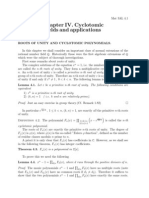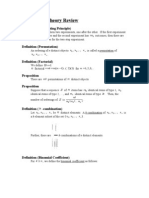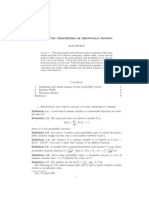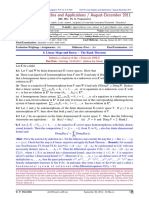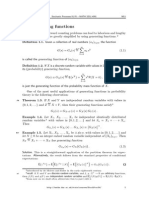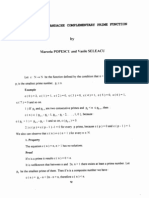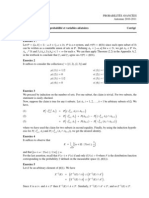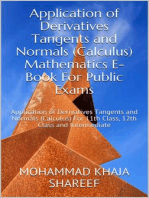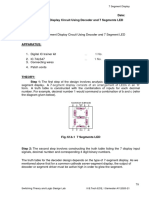0 ratings0% found this document useful (0 votes)
28 viewsCounting Methods and The Pigeonhole Principle
Counting Methods and The Pigeonhole Principle
Uploaded by
Mohammad Gulam AhamadThis document discusses counting methods and the pigeonhole principle. It covers topics like the multiplication and addition principles, permutations and combinations, binomial coefficients, probability, and the pigeonhole principle. Some key points are:
- The multiplication principle states that if an activity can be done in k steps, and step 1 can be done in n1 ways, step 2 in n2 ways, etc., the total number of ways is n1n2...nk.
- A permutation is an ordering of elements, and there are n! permutations of n distinct elements. A combination is an unordered selection of elements.
- The pigeonhole principle states that if n items are put into k < n containers, some
Copyright:
Attribution Non-Commercial (BY-NC)
Available Formats
Download as PPT, PDF, TXT or read online from Scribd
Counting Methods and The Pigeonhole Principle
Counting Methods and The Pigeonhole Principle
Uploaded by
Mohammad Gulam Ahamad0 ratings0% found this document useful (0 votes)
28 views23 pagesThis document discusses counting methods and the pigeonhole principle. It covers topics like the multiplication and addition principles, permutations and combinations, binomial coefficients, probability, and the pigeonhole principle. Some key points are:
- The multiplication principle states that if an activity can be done in k steps, and step 1 can be done in n1 ways, step 2 in n2 ways, etc., the total number of ways is n1n2...nk.
- A permutation is an ordering of elements, and there are n! permutations of n distinct elements. A combination is an unordered selection of elements.
- The pigeonhole principle states that if n items are put into k < n containers, some
Original Description:
Couting methods and piegion hole principles
Original Title
ch4Discretemaths
Copyright
© Attribution Non-Commercial (BY-NC)
Available Formats
PPT, PDF, TXT or read online from Scribd
Share this document
Did you find this document useful?
Is this content inappropriate?
This document discusses counting methods and the pigeonhole principle. It covers topics like the multiplication and addition principles, permutations and combinations, binomial coefficients, probability, and the pigeonhole principle. Some key points are:
- The multiplication principle states that if an activity can be done in k steps, and step 1 can be done in n1 ways, step 2 in n2 ways, etc., the total number of ways is n1n2...nk.
- A permutation is an ordering of elements, and there are n! permutations of n distinct elements. A combination is an unordered selection of elements.
- The pigeonhole principle states that if n items are put into k < n containers, some
Copyright:
Attribution Non-Commercial (BY-NC)
Available Formats
Download as PPT, PDF, TXT or read online from Scribd
Download as ppt, pdf, or txt
0 ratings0% found this document useful (0 votes)
28 views23 pagesCounting Methods and The Pigeonhole Principle
Counting Methods and The Pigeonhole Principle
Uploaded by
Mohammad Gulam AhamadThis document discusses counting methods and the pigeonhole principle. It covers topics like the multiplication and addition principles, permutations and combinations, binomial coefficients, probability, and the pigeonhole principle. Some key points are:
- The multiplication principle states that if an activity can be done in k steps, and step 1 can be done in n1 ways, step 2 in n2 ways, etc., the total number of ways is n1n2...nk.
- A permutation is an ordering of elements, and there are n! permutations of n distinct elements. A combination is an unordered selection of elements.
- The pigeonhole principle states that if n items are put into k < n containers, some
Copyright:
Attribution Non-Commercial (BY-NC)
Available Formats
Download as PPT, PDF, TXT or read online from Scribd
Download as ppt, pdf, or txt
You are on page 1of 23
Counting methods
and the pigeonhole principle
4.1 Basic principles
Multiplication principle
If an activity can be performed in k
successive steps,
Step 1 can be done in n
1
ways
Step 2 can be done in n
2
ways
Step k can be done in n
k
ways
Then: the number of different ways that the
activity can be performed is the product
n
1
n
2
n
k
Addition principle
Let X
1
, X
2
,, X
k
be a collection of k
pairwise disjoint sets, each of which has n
j
elements, 1 < j < k, then the union of
those sets
k
X = X
j
j =1
has n
1
+ n
2
+ + n
k
elements
4.2 Permutations and combinations
A permutation of n distinct elements x
1
, x
2
,, x
n
is an ordering of the n elements. There are n!
permutations of n elements.
Example: there are 3! = 6 permutations of three
elements a, b, c:
abc bac cab
acb bca cba
r-permutations
An r-permutation of n distinct elements is an
ordering of an r-element subset of the n
elements x
1
, x
2
,, x
n
Theorem 4.2.10:
For r < n the number of r-permutations of a set
with n distinct objects is
P(n,r) = n(n-1)(n-2)(n-r+1) = n !/(n-r) !
If r = n, P(n,n) = n !
Combinations
Let X = {x
1
, x
2
,, x
n
} be a set containing n
distinct elements
An r-combination of X is an unordered
selection of r elements of X, for r < n
The number of r-combinations of X is the
binomial coefficient
C(n,r) = = n! / r!(n-r)! = P(n,r)/ r!
Catalan numbers
Eugene-Charles Catalan (1814-1894)
Catalan numbers are defined by the formula
C
n
= C(2n,n) / (n+1)
for n = 0, 1, 2,
The first few terms are:
n 0 1 2 3 4 5 6 7 8 9 10
C
n
1 1 2 5 14 42 132 429 1430 4862 16796
4.3 Algorithms for generating
permutations and combinations
Lexicographic order:
Given two strings o = s
1
s
2
s
p
and | = t
1
t
2
t
q
Define o < | if
p < q and s
i
= t
i
for all i = 1, 2,, p
Or for some i, s
i
= t
i
and for the smallest i, s
i
< t
i
Example: if o = 1324, | = 1332, = 132,
then < o and o < |.
4.4 Introduction to
discrete probability
An experiment is a process that yields an
outcome
An event is an outcome or a set of outcomes
from an experiment
The sample space is the event of all possible
outcomes
Probability
Probability of an event is the number of
outcomes in the event divided by the number of
outcomes in the sample space.
If S is a finite sample space and E is an event
(E is a subset of S) then the probability of E is
P(E) = |E| / |S|
4.5 Discrete probability theory
When all outcomes are equally likely and
there are n possible outcomes, each one
has a probability 1/n.
BUT this is not always the case. When
all probabilities are not equal, then some
probability (possibly different numbers)
must be assigned to each outcome.
Probability function
A probability function P is a function from
the set of all outcomes (sample space S) to
the interval [0, 1], in symbols
P : S [0, 1]
The probability of an event E _ S is the sum
of the probabilities of every outcome in E
P(E) = E P(x)
x e E
Probability of an event
Given E _ S, we have
0 < P(E) < P(S) = 1
If S = {x
1
, x
2
,, x
n
} is a sample space, then
n
P(S) = E P(x
i
) = 1
i =1
If E
c
is the complement of E in S, then
P(E) + P(E
c
) = 1
Events in a sample space
Given any two events E
1
and E
2
in a sample
space S. Then
P(E
1
E
2
) = P(E
1
) + P(E
2
) P(E
1
E
2
)
We also have P(C) = 0
Events E
1
and E
2
are mutually exclusive if and
only if E
1
E
2
= C. In this case
P(E
1
E
2
) = P(E
1
) + P(E
2
)
Conditional probability
Conditional probability is the probability of an
event E, given that another event F has
occurred, is called. In symbols P(E|F).
If P(F) > 0 then
P(E|F) = P(EF) / P(F)
Two events E and F are independent if
P(EF) = P(E)P(F)
Pattern recognition
Pattern recognition places items into classes,
based on various features of the items.
Given a set of features F we can calculate the
probability of a class C, given F: P(C|F)
Place the item into the most probable class, i.e.
the one C for which P(C|F) is the highest.
Example: Wine can be classified as Table wine (T), Premium (R)
or Swill (S). Let F e {acidity, body, color, price}
Suppose a wine has feature F, and P(T|F) = 0.5, P(R|F) = 0.2
and P(S|F) = 0.3. Since P(T|F) is the highest number, this wine
will be classified as table wine.
Bayes Theorem
Given pairwise disjoint classes C
1
, C
2
,,
C
n
and a feature set F, then
P(C
j
|F) = A / B, where
A = P(F|C
j
)P(C
j
)
n
and B = E P(F|C
i
)P(C
i
)
i = 1
Generalized permutations
and combinations
Theorem 4.6.2: Suppose that a sequence of n
items has n
j
identical objects of type j,
for 1< j < k. Then the number of orderings of S
is
____n!____
n
1
!n
2
!...n
k
!
4.7 Binomial coefficients
and combinatorial identities
Theorem 4.7.1: Binomial theorem. For any real
numbers a, b, and a nonnegative integer n:
(a+b)
n
= C(n,0)a
n
b
0
+ C(n,1)a
n-1
b
1
+
+ C(n,n-1)a
1
b
n-1
+ C(n,n)a
0
b
n
n
(a+b)
n
= E C(n,k) a
n-k
b
k
k = 0
Theorem 4.7.6: For 1 < k < n,
C(n+1,k) = C(n,k) + C(n,k-1) and
n
E C(i,k) = C(n+1,k+1)
i = k
Pascals Triangle
1
1 1
1 2 1
1 3 3 1
1 4 6 4 1
1 5 10 10 5 1
1 6 15 20 15 6 1
1 7 21 35 35 21 7 1
1 8 28 56 70 56 28 8 1
1 9 36 84 126 126 84 36 9 1
4.8 The pigeonhole principle
First form: If k < n and n pigeons fly into k
pigeonholes, some pigeonhole contains at least
two pigeons.
Second form of the
pigeonhole principle
If X and Y are finite sets with |X| > |Y| and
f : X Y is a function, then f(x
1
) = f(x
2
) for
some x
1
, x
2
e X, x
1
= x
2
.
Third form of the
pigeonhole principle
If X and Y are finite sets with |X| = n, |Y| = m
and k = n/m(, then there are at least k values
a
1
, a
2
,, a
k
e X such that f(a
1
) = f(a
2
) = f(a
k
).
Example:
n = 5, m = 3
k = n/m( = 5/3( = 2.
You might also like
- Oral Practise & Oral Test English F3Document40 pagesOral Practise & Oral Test English F3Nidhis Kumar100% (1)
- Hw2sol PDFDocument15 pagesHw2sol PDFPei JingNo ratings yet
- PSVs CalculationDocument24 pagesPSVs Calculationionutlaur86100% (3)
- ch4 - Counting PrincipleDocument23 pagesch4 - Counting PrincipleMohammad Gulam AhamadNo ratings yet
- The Fast Fourier TransformDocument20 pagesThe Fast Fourier TransformdrnitkNo ratings yet
- The Fast Fourier TransformDocument20 pagesThe Fast Fourier TransformAmir WagdarikarNo ratings yet
- 2nd Unit DmaDocument35 pages2nd Unit DmaDr. Ramu Kuchipudi Associate Professor (Contract)No ratings yet
- Reciprocidade Problemas Resolvidos PDFDocument13 pagesReciprocidade Problemas Resolvidos PDFLuís Farias100% (2)
- On A Class of Sums Involving The Floor Function: Titu Andreescu and Dorin AndricaDocument5 pagesOn A Class of Sums Involving The Floor Function: Titu Andreescu and Dorin AndricaDương Minh ĐứcNo ratings yet
- Rudin 2Document24 pagesRudin 2William CarvajalNo ratings yet
- The Euclidean Space: Agata Darmochwał Warsaw University BiałystokDocument5 pagesThe Euclidean Space: Agata Darmochwał Warsaw University Białystoktrisha.black6No ratings yet
- FFT Notes - Julius Dichter, University of Bridgeport © 2003Document8 pagesFFT Notes - Julius Dichter, University of Bridgeport © 2003zyx886No ratings yet
- Cyclotomic Fields and ApplicationsDocument18 pagesCyclotomic Fields and ApplicationsChan Yu HinNo ratings yet
- 170 Are ViewDocument12 pages170 Are Viewjason.kerwinNo ratings yet
- CS103X: Discrete Structures Homework Assignment 5: Due February 29, 2008Document3 pagesCS103X: Discrete Structures Homework Assignment 5: Due February 29, 2008Muhammad Ali FîdåNo ratings yet
- Elements of ProbabilityDocument7 pagesElements of ProbabilityjedacobNo ratings yet
- BechorDocument8 pagesBechorEpic WinNo ratings yet
- Lec 12Document6 pagesLec 12spitzersglareNo ratings yet
- Abstract Algebra SolutionsDocument141 pagesAbstract Algebra SolutionsThigpen Fockspace88% (8)
- 1 s2.0 S0047259X9991864X MainDocument27 pages1 s2.0 S0047259X9991864X MainRabaouiNo ratings yet
- MIT18 781S12 Lec3 PDFDocument6 pagesMIT18 781S12 Lec3 PDFABhijithNo ratings yet
- IMC 2010 (Day 2)Document4 pagesIMC 2010 (Day 2)Liu ShanlanNo ratings yet
- STAT 103 Practice MidtermDocument10 pagesSTAT 103 Practice MidtermSusan “Susie Que” JonesNo ratings yet
- E0 219 Linear Algebra and Applications / August-December 2011Document8 pagesE0 219 Linear Algebra and Applications / August-December 2011Chayan GhoshNo ratings yet
- Solution.: D - N D - N D - NDocument5 pagesSolution.: D - N D - N D - NtonynuganNo ratings yet
- Generating FunctionsDocument6 pagesGenerating FunctionsEverton ArtusoNo ratings yet
- 1a87060a-807f-41df-8298-c4fa65f97da6Document23 pages1a87060a-807f-41df-8298-c4fa65f97da6James HickmanNo ratings yet
- Markov Chains: 4.1 Stochastic ProcessesDocument42 pagesMarkov Chains: 4.1 Stochastic ProcessesDimas AdipNo ratings yet
- About The Smarandache Complementary Prime FunctionDocument11 pagesAbout The Smarandache Complementary Prime FunctionMia AmaliaNo ratings yet
- Principles of Mathematical Analysis Rudin SolutionsDocument99 pagesPrinciples of Mathematical Analysis Rudin Solutionstimcantango100% (6)
- L Norms of Trigonometric Polynomials: N K Ikt KDocument11 pagesL Norms of Trigonometric Polynomials: N K Ikt KMathSpaceNo ratings yet
- Midterm SolutionsDocument5 pagesMidterm SolutionsLinbailuBellaJiangNo ratings yet
- Advanced Calculus-Midterm Exam 1Document5 pagesAdvanced Calculus-Midterm Exam 1longrio.financesNo ratings yet
- CS 109: Probability For Computer Scientists Section 1: Intro To ProbabilityDocument2 pagesCS 109: Probability For Computer Scientists Section 1: Intro To ProbabilityJordi ArnauNo ratings yet
- N 0 N TH NDocument6 pagesN 0 N TH NPallav AnandNo ratings yet
- Weatherwax - Conte - Solution - Manual Capitulo 2 y 3Document59 pagesWeatherwax - Conte - Solution - Manual Capitulo 2 y 3Jorge EstebanNo ratings yet
- Part-A - Unit-2-2023Document2 pagesPart-A - Unit-2-2023csbs269035No ratings yet
- Solution of Exercises of 7.5 and 7.6Document6 pagesSolution of Exercises of 7.5 and 7.6Mayank BhartiNo ratings yet
- Solutions Rudin - 2 PDFDocument24 pagesSolutions Rudin - 2 PDFSera Hernandez PuenteNo ratings yet
- International Competition in Mathematics For Universtiy Students in Plovdiv, Bulgaria 1995Document11 pagesInternational Competition in Mathematics For Universtiy Students in Plovdiv, Bulgaria 1995Phúc Hảo ĐỗNo ratings yet
- Corrige 2Document2 pagesCorrige 2Ayoub Yob'No ratings yet
- Analysis And Design Of Algoritms Wk 4-8Document91 pagesAnalysis And Design Of Algoritms Wk 4-8roman.njorogeNo ratings yet
- MC0074 - Set 2Document4 pagesMC0074 - Set 2nikeneelNo ratings yet
- Cryptography PDFDocument23 pagesCryptography PDFnicolasNo ratings yet
- Numerical Functions and TripletsDocument6 pagesNumerical Functions and TripletsMia AmaliaNo ratings yet
- Analytic Number Theory Winter 2005 Professor C. StewartDocument35 pagesAnalytic Number Theory Winter 2005 Professor C. StewartTimothy P0% (1)
- Fundamentalsof Theoryof NumbersDocument76 pagesFundamentalsof Theoryof NumbersLaptop of AkashNo ratings yet
- hw7 Sol-1Document7 pageshw7 Sol-1licodo9896No ratings yet
- Zuming Feng Number Theory Mathematics Olympiad Coachs Seminar Coachnums Some Solutions 2004 22pDocument22 pagesZuming Feng Number Theory Mathematics Olympiad Coachs Seminar Coachnums Some Solutions 2004 22pEmerson Soriano100% (1)
- Some Remarks On The Smarandache FunctionDocument5 pagesSome Remarks On The Smarandache FunctionMia AmaliaNo ratings yet
- Trigonometric Ratios to Transformations (Trigonometry) Mathematics E-Book For Public ExamsFrom EverandTrigonometric Ratios to Transformations (Trigonometry) Mathematics E-Book For Public ExamsRating: 5 out of 5 stars5/5 (1)
- De Moiver's Theorem (Trigonometry) Mathematics Question BankFrom EverandDe Moiver's Theorem (Trigonometry) Mathematics Question BankNo ratings yet
- Application of Derivatives Tangents and Normals (Calculus) Mathematics E-Book For Public ExamsFrom EverandApplication of Derivatives Tangents and Normals (Calculus) Mathematics E-Book For Public ExamsRating: 5 out of 5 stars5/5 (1)
- Mathematics 1St First Order Linear Differential Equations 2Nd Second Order Linear Differential Equations Laplace Fourier Bessel MathematicsFrom EverandMathematics 1St First Order Linear Differential Equations 2Nd Second Order Linear Differential Equations Laplace Fourier Bessel MathematicsNo ratings yet
- Functional Operators, Volume 2: The Geometry of Orthogonal SpacesFrom EverandFunctional Operators, Volume 2: The Geometry of Orthogonal SpacesNo ratings yet
- Differential Equations (Calculus) Mathematics E-Book For Public ExamsFrom EverandDifferential Equations (Calculus) Mathematics E-Book For Public ExamsRating: 5 out of 5 stars5/5 (1)
- Control Systems1Document19 pagesControl Systems1Mohammad Gulam AhamadNo ratings yet
- Control Systems1Document19 pagesControl Systems1Mohammad Gulam AhamadNo ratings yet
- Distributed Systems Architectures: Architectural Design For Software That Executes On More Than One ProcessorDocument44 pagesDistributed Systems Architectures: Architectural Design For Software That Executes On More Than One ProcessorMohammad Gulam AhamadNo ratings yet
- Examples OfzTransformDocument17 pagesExamples OfzTransformMohammad Gulam Ahamad100% (1)
- Donors and Acceptors in SemiconductorsDocument28 pagesDonors and Acceptors in SemiconductorsMohammad Gulam AhamadNo ratings yet
- Client Server and ProtocolsDocument18 pagesClient Server and ProtocolsMohammad Gulam AhamadNo ratings yet
- PIC MicrocontrollersDocument20 pagesPIC MicrocontrollersMohammad Gulam Ahamad67% (3)
- m6 GameDocument21 pagesm6 GameMohammad Gulam AhamadNo ratings yet
- Data Structures-TreesDocument40 pagesData Structures-TreesMohammad Gulam Ahamad100% (3)
- Application of Image Enhancement Techniques To Magnetic Resonance ImagingDocument14 pagesApplication of Image Enhancement Techniques To Magnetic Resonance ImagingMohammad Gulam AhamadNo ratings yet
- IntrotocomputerDocument16 pagesIntrotocomputerMohammad Gulam AhamadNo ratings yet
- AIDocument9 pagesAIMohammad Gulam AhamadNo ratings yet
- MPC555 IoDocument24 pagesMPC555 IoMohammad Gulam AhamadNo ratings yet
- Dr. Mohammed Gulam AhamadDocument37 pagesDr. Mohammed Gulam AhamadMohammad Gulam AhamadNo ratings yet
- MPC555Document27 pagesMPC555Mohammad Gulam AhamadNo ratings yet
- COA SuperTab 21AN 10BFWLNDocument2 pagesCOA SuperTab 21AN 10BFWLNsuryadi.widjayaNo ratings yet
- PhotogrammetryDocument8 pagesPhotogrammetrytharunkuttiNo ratings yet
- SPAIN Tourism Overtourism PresentationDocument14 pagesSPAIN Tourism Overtourism PresentationОлександр НісковNo ratings yet
- Little Helper. Igantic Effect!: 150 VarioDocument12 pagesLittle Helper. Igantic Effect!: 150 Variokgv_mailsNo ratings yet
- A Glossary of Important Symbols in The Hebrew Pagan and Christian Forms Hall A SDocument120 pagesA Glossary of Important Symbols in The Hebrew Pagan and Christian Forms Hall A SRon100% (11)
- Chapter 9 - Benzene and Its DerivativesDocument71 pagesChapter 9 - Benzene and Its Derivativesuypaul97No ratings yet
- PIQC Lecture 7Document251 pagesPIQC Lecture 7sekhara2zNo ratings yet
- Assessing Rock Compressive Strength and Predicting Formation Drillability Using Sonic, Gamma & Density LogsDocument7 pagesAssessing Rock Compressive Strength and Predicting Formation Drillability Using Sonic, Gamma & Density Logsflasher_for_nokiaNo ratings yet
- Q.1 Meaning & Nature of Operation Management? Explain Product Design & Process Design..?Document14 pagesQ.1 Meaning & Nature of Operation Management? Explain Product Design & Process Design..?Pooja RajputNo ratings yet
- Hydrotest Pressure Procedure - 2023Document15 pagesHydrotest Pressure Procedure - 2023Amit HasanNo ratings yet
- Chromagar BBLDocument3 pagesChromagar BBLapi-26429188No ratings yet
- Design Method For Anchorage of Post-Installed Reinforcing Bars (Rebars) With Improved Bond-Splitting Behavior As Compared To EN 1992-1-1Document22 pagesDesign Method For Anchorage of Post-Installed Reinforcing Bars (Rebars) With Improved Bond-Splitting Behavior As Compared To EN 1992-1-1soufiane laaouaniNo ratings yet
- Explicacion K PDFDocument10 pagesExplicacion K PDFLeidy Renteria EstradaNo ratings yet
- Numerical Reasoning Notes PDF 62Document10 pagesNumerical Reasoning Notes PDF 62Rupesh soniNo ratings yet
- FeminismDocument17 pagesFeminismХристина МарчукNo ratings yet
- Management EngineeringDocument85 pagesManagement Engineeringaegis06No ratings yet
- Excavation Design in Massive Elastic RockDocument27 pagesExcavation Design in Massive Elastic RockYassinElhasnaouiNo ratings yet
- Christine Ritter: Evisu Banbu ReportDocument32 pagesChristine Ritter: Evisu Banbu ReportUtkan AlpNo ratings yet
- ABB WhitePaper 4MWh Utility Scale Energy Storage ShortDocument34 pagesABB WhitePaper 4MWh Utility Scale Energy Storage Shortsamir100% (1)
- Digital Agriculture Profile - EthiopiaDocument21 pagesDigital Agriculture Profile - EthiopiaNolawiNo ratings yet
- B 7 Segment Display DecoderDocument8 pagesB 7 Segment Display Decoderlokesh krapaNo ratings yet
- Exploding Foil Initiator PDFDocument5 pagesExploding Foil Initiator PDFdanNo ratings yet
- Project With Kmno4Document3 pagesProject With Kmno4Shandev IndoiNo ratings yet
- Operations Management Chapter 2Document9 pagesOperations Management Chapter 2Eyob FekaduNo ratings yet
- Engine 55-L-714Document92 pagesEngine 55-L-714Georgios Roumpies100% (1)
- Krishna Institute of Engineering & Technology, GhaziabadDocument4 pagesKrishna Institute of Engineering & Technology, GhaziabadkapilkietNo ratings yet
- The Inner Meaning of Sagar Manthan.Document212 pagesThe Inner Meaning of Sagar Manthan.Dhruva KashyapNo ratings yet
- The Art of DevotionDocument3 pagesThe Art of DevotionMahasiddha YogaNo ratings yet













